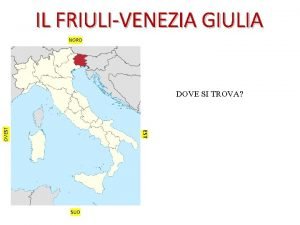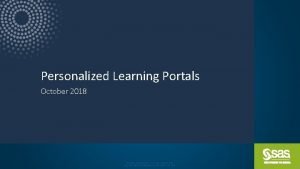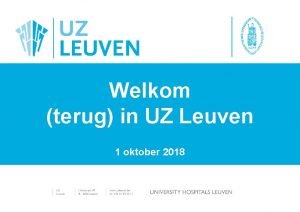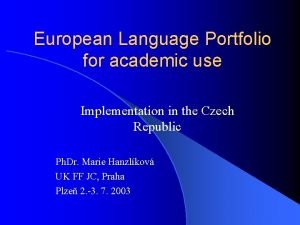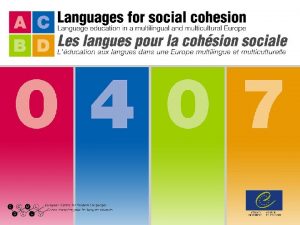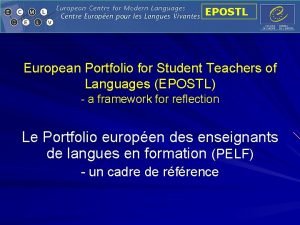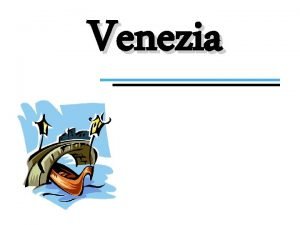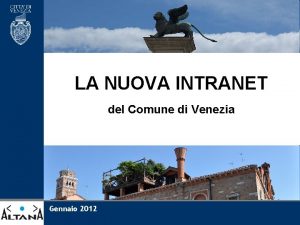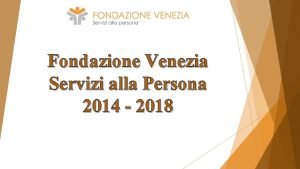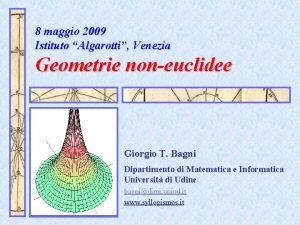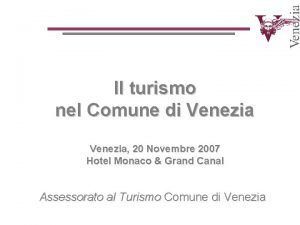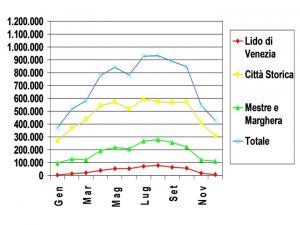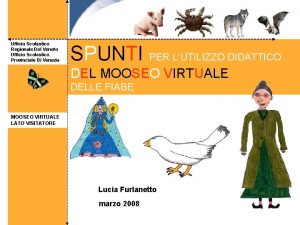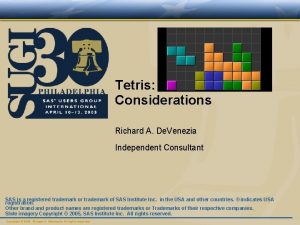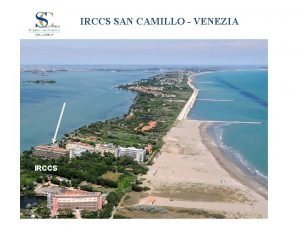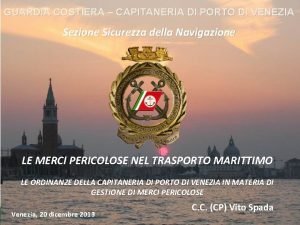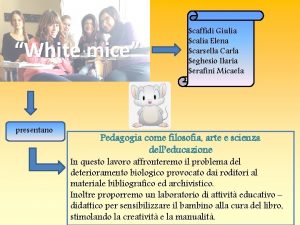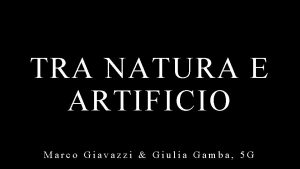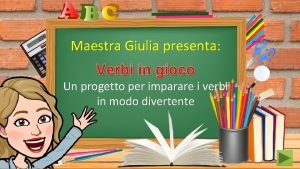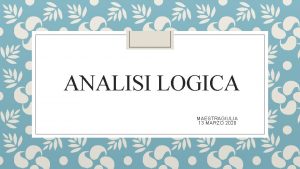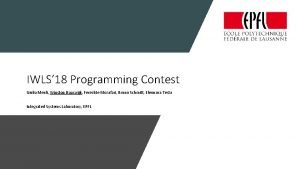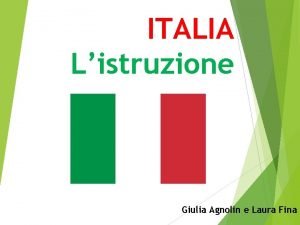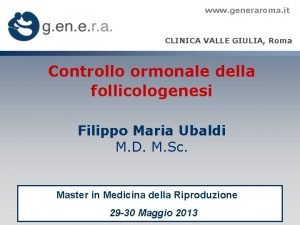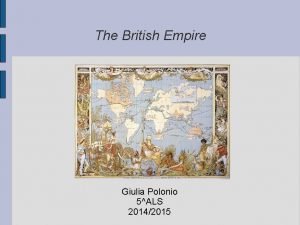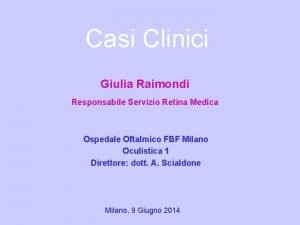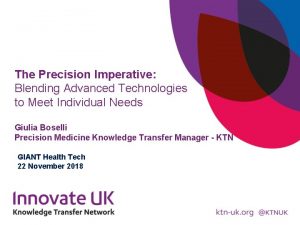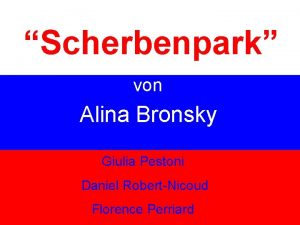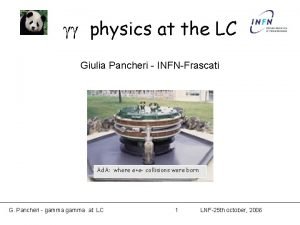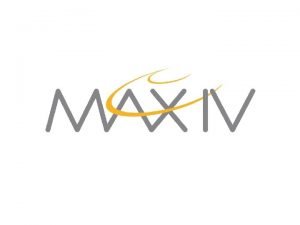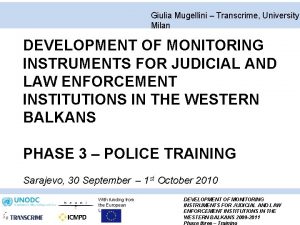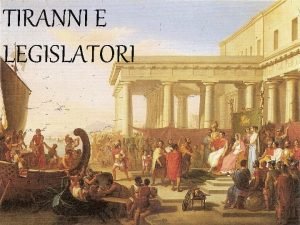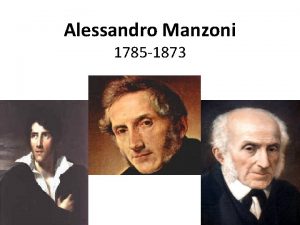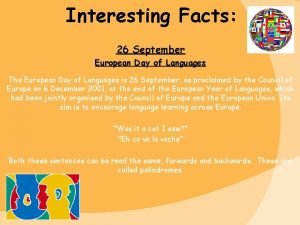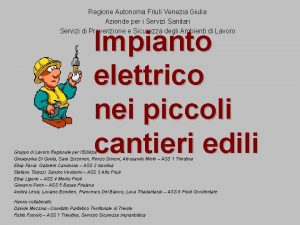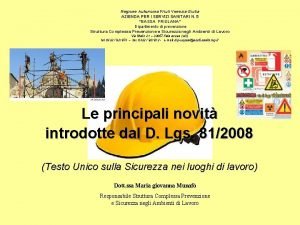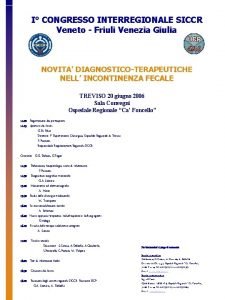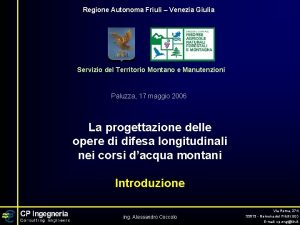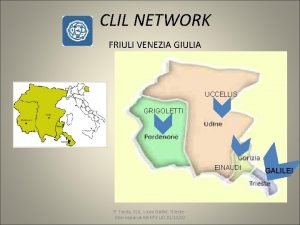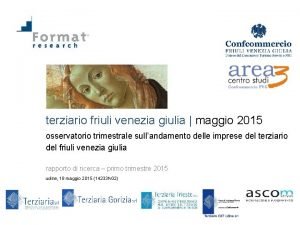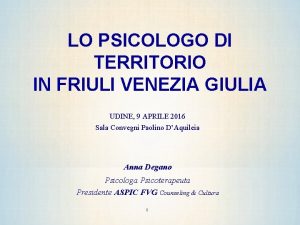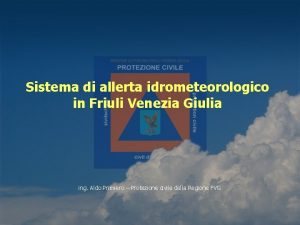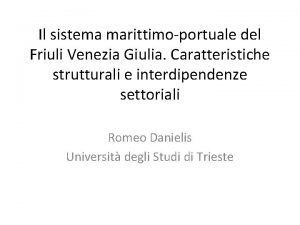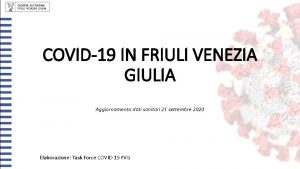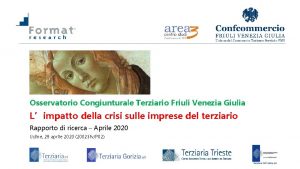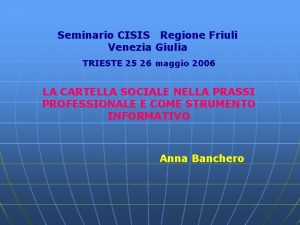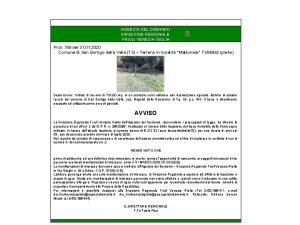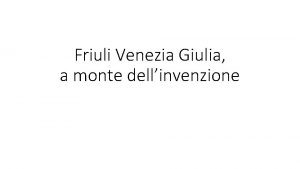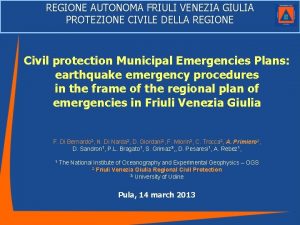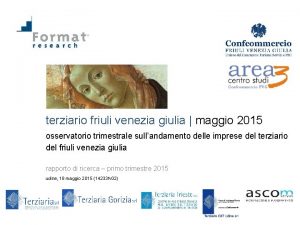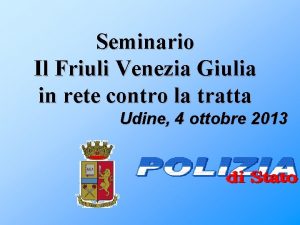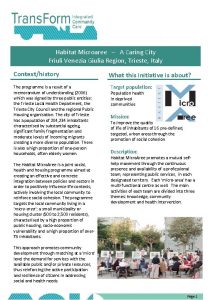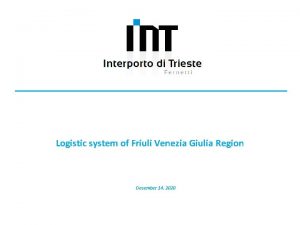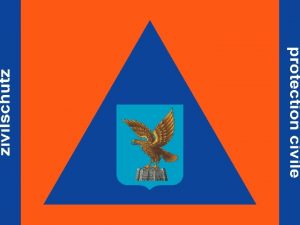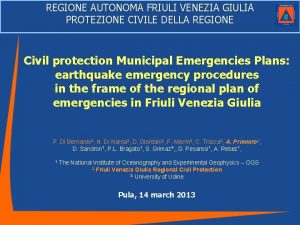IAL Friuli Venezia Giulia The European Language Portfolio

























































- Slides: 57

IAL Friuli Venezia Giulia The European Language Portfolio ( ELP) and Responsibilities of ALTE Members Giorgia Costalonga Lewisham College, Skills for Life Professional Development Centre 22 nd – 23 rd September 2005

European Language Portfolio (ELP) The European Language Portfolio was developed and piloted by the Language Policy Division of the Council of Europe, Strasbourg, from 1998 until 2000 (Recommendation N° R (98) 6/Resolution on the European Language Portfolio. )

What is a European Language Portfolio? It is a document in which those who are learning or have learned a language - whether at school or outside school – can record and reflect on their language learning and cultural experiences.

THE LANGUAGE PASSPORT n provides: n an overview of the individual’s proficiency in different languages at a given point in time

THE LANGUAGE PASSPORT n The overview is defined in terms of:

THE LANGUAGE PASSPORT records: n formal qualifications and describes language competencies and significant language and intercultural learning experiences. n includes: n information on partial and specific competence

THE LANGUAGE PASSPORT Allows for: self-assessment n teacher assessment n assessment by educational institutions examinations boards. . n and

THE LANGUAGE PASSPORT n requires that information entered in the Passport states on: what basis n when n by whom the assessment was carried out n

THE LANGUAGE PASSPORT To facilitate pan-European recognition and mobility a standard presentation of a Passport Summary is promoted by the Council of Europe for ELPs for adults.

THE LANGUAGE PASSPORT n The portfolio contains a: n language passport which its owner regularly updates

THE ELP IS COMPOSED BY: n 1) a GRID: is provided where his/her language competences can be described according to common criteria accepted throughout Europe and which can serve as a complement to customary certificates

THE ELP IS COMPOSED BY: n 2) a detailed LANGUAGE BIOGRAPHY describing the owner's experiences in each language and which is designed to guide the learner in planning and assessing progress.

THE ELP IS COMPOSED BY: n 3) a DOSSIER where examples of personal work can be kept to illustrate one's language competences

AIMS and FUNCTIONS of a European Language Portfolio The European Language Portfolio project has two main aims: to motivate learners by acknowledging their efforts to extend and diversify their language skills at all levels n to provide a record of the linguistic and cultural skills they have acquired (to be consulted, for example, when they are moving to a higher learning level or seeking employment at home or abroad) n

WHAT IS THE ELP’S FUNCTION? 1. Reporting It displays the owner’s capabilities, but in relation to foreign languages. Its purpose is not to replace the certificates and diplomas that are awarded on the basis of formal examinations but to supplement them by presenting additional information about the owner’s experience and concrete evidence of his or her foreign language achievements.

WHAT IS THE ELP’S FUNCTION? This function coincides with the Council of Europe’s interest in: n n facilitating individual mobility relating regional and national qualifications to internationally agreed standards

WHAT IS THE ELP’S FUNCTION? Clearly, the importance of the ELP’s reporting function will vary according to the age of the owner (usually much less important for learners in the earlier stages of schooling than for those approaching the end of formal education or already in employment). That explains why the Council of Europe has introduced a standard passport …. . .

WHAT IS THE ELP’S FUNCTION? 2. Pedagogical The ELP is also intended to be used as: n n a means of making the language learning process more transparent to learners, helping them to develop their capacity for reflection and self-assessment; and thus enabling them gradually to assume more and more responsibility for their own learning.

WHAT IS THE ELP’S FUNCTION? This function coincides with the Council of Europe’s interest in fostering the development of learner autonomy and promoting lifelong learning.

The skills referred to in the language passport are: n n n UNDERSTANDING (LISTENING and READING) SPEAKING (SPOKEN INTERACTION and SPOKEN PRODUCTION) WRITING

THE COMMON EUROPEAN FRAMEWORK LEVELS n BASIC USER (A 1: BREAKTHROUGH and A 2: WAYSTAGE) n INDEPENDENT USER (B 1: THRESHOLD and B 2: VANTAGE) n PROFICIENT USER (C 1: EFFECTIVE OPERATIONAL PROFICIENCY and C 2: MASTERY)

HOW MIGHT YOUR LEARNERS USE THEIR ELP? n Some of your learners are looking for jobs…. . They would like to present their ELP to potential employers in order to show their foreign language abilities, experience and qualifications.

HOW MIGHT YOUR LEARNERS USE THEIR ELP? Is a good idea…. make a note of at least three situations in which your learners could present their ELP… n n n What would you like to find in the ELP if you were an employer? What qualities would you particularly appreciate in an applicant? How do you think these qualities could best be expressed in the ELP?

HOW CAN THE ELP SUPPORT YOUR TEACHING? The suggestion is: make brief notes under the following headings. . n n How How I I Organize my Teaching? prepare my Teaching? use the Textbook? assess my learners?

IAL Experience …. Making time… IAL teachers are busy people who come under pressure from many directions…. At any one time they are responsible for several different classes.

IAL Experience …. Making time… With all these different demands to cope with, there is all too little time for the kind of reflection that leads to experimentation and innovation in the classroom.

IAL Experience …. Making time… It is thus hardly surprising that these teachers often expressed concern that working with the ELP made additional demands on their time.

IAL Experience …. Making time… Alessandra said… “…I learnt a lot about my students, their motivation and their potential, but I also needed more time to prepare my lessons, to cope with a new experience, to give feedback and to discuss with individual students. I think the effort was worthwhile but I am not sure that I can maintain the additional effort needed unless it becomes part of my normal work load…!”

IAL Experience …. Making time… Many teachers involved in our Institutions (IAL FVG) described the ELP’s pedagogical function as: n making the language learning process more transparent to learners nhelping them to develop their capacity for reflection and self-assessment. . . And thus enabling them gradually to assume more and more responsibility for their own learning.

IAL Experience …. Making time… When these things happen, teachers do not become less busy, but life becomes easier and teaching more enjoyable because their learners understand that they too are responsible for what goes on in the classroom.

IAL Experience …. Making time… Any change or innovation requires extra effort to begin with, and that means extra time. n But we are confident that if the pedagogical function of the ELP takes root, it will quickly bring about a reorientation in learners that is very beneficial to teachers.

IAL Experience …. Making time… n There is likewise no contradiction between the ELP and the textbook, though the ELP’s pedagogical function has unmistakable implications for the way in which the teachers use the textbook. n If they are to engage their learners in reflection and self-assessment and thus enable them to assume responsibility for their own learning, the teachers cannot use the textbook as a series of lesson scripts.

IAL Experience …. Making time… Feedback from our teacher…Maddalena said… “For to do so. . would be to impose on our learners the textbook author’s learning targets and implied learning process. By working with the ELP we commit ourselves to an ongoing process of discussion and negotiation with our learners to which the textbook must always remain subordinate…. This means that we must use the textbook flexibly and imaginatively. Sometimes it may be appropriate to allow our learners to choose which parts of the textbook we want to work with”.

IAL Experience …. Understanding and using the common reference levels and descriptors The Council of Europe’s common reference levels are fundamental to the ELP. …… The summary of the common reference levels provided by the self-assessment grid in the language passport has given rise… to our teachers………. . some kinds of problem…

IAL Experience …. Understanding and using the common reference levels and descriptors For instance… n. I’ve got problems identifying particular levels. n. The descriptors are too general. n It would help if the range of knowledge in individual levels was specified more precisely. The first problem can be solved by recognizing that each of the general descriptors in the language passport must be expanded in a way appropriate to the age, needs and interests of the learners in question.

IAL Experience …. The illustrative scales and the self-assessment checklists provide invaluable help, but it is also worth bearing in mind that………. . the learners themselves can contribute to the process. The expansion should produce lists of precise communicative goals that can be used to generate learning tasks.

IAL Experience …. Take, for example, READING at the lowest level, A 1: I can understand familiar names, words and very simple sentences, for example on notices and posters or in catalogues. … This descriptor summarizes the most basic communicative use that it is possible to make of the reading skill…. . but the communicative behaviour in which such use is embedded will vary from one learner group to another.

IAL Experience …. For instance, It will seem natural to most adult learners that they should develop this foundational reading skill by working with notices, posters and catalogues drawn from the real world… …. whereas… In a primary classroom it may make a lot more sense for the teacher and learners to devise their own posters and notices naming classroom objects and reminding learners of frequently used phrases and classroom instructions.

IAL Experience …. Similarly, the descriptor for WRITING at level B 1 – I can write simple connected text on topics which are familiar or of personal interest. I can write personal letters describing experiences and impressions –will necessarily yield different topics and a different range of experiences and impressions from one learner group to another.

IAL Experience …. n The second problem was that some teachers found the descriptors too general for learners to be able to identify their progress even over an extended period of time. . .

IAL Experience …. The levels in the Common European Framework are so broad that they do not allow the great majority of learners to appreciate the progress they have made over a considerable period, e. g. , a whole school year. This demotivates the learners and they quickly lose …. .

IAL Experience …. n The first point to make in response to this problem is that : the summary of skills and levels included in the ELP language passport covers the whole range of possible foreign language proficiency, from beginner to near-native speaker.

IAL Experience …. Only a very small percentage of learners achieve levels C 1 and C 2, and they do so only after many years of learning. It is thus hardly surprising that learners remain at the same Council of Europe level for months, or in some cases years, even though there may be plenty of evidence that they are making progress.

IAL Experience …. If they are using the ELP, the biography rather than the passport will be the chief focus for setting and reviewing learning targets, and the profile of language skills in the passport will be revisited only occasionally.

The profile of language skills …note that there are several ways of filling in the profile of language skills…. One is: n n by ticking the boxes for the different skills and levels when those skills and levels have been achieved; another is by shading in the boxes gradually, as progress is made towards total mastery of each level.

The Levels and scales. . . Talking in terms of the series of Council of Europe content specifications, even if Waystage [A 2] is situated halfway to Threshold Level [B 1] on a scale of levels and Threshold half way to Vantage Level [B 2]…. . experience with existing scales suggests that many learners will take more than twice as long to reach Threshold from Waystage than they needed to reach Waystage.

The Levels and scales. . . They will then probably need more than twice as long to reach Vantage from Threshold than they needed to reach Threshold from Waystage – even if the levels appear to be equidistant on the scale.

The Levels and scales. . . This is because of the necessary broadening of the range of activities, skills and language involved. This fact of life is reflected in the frequent presentation of a scale of levels with a diagram like an ice cream cornet, a three dimensional cone which broadens towards the top.

The Levels and scales. . . Extreme caution should be exercised in using any scale of levels to calculate the “mean seat time” necessary to meet particular objectives.

The number of words…. The same kind of point can be made in relation to the number of words that learners need in order to be able to perform adequately at the different levels. A vocabulary of about 850 words is required for A 2…. . about 1, 500 for B 1 (The Threshold Level).

The number of words…. . . But it has been calculated that in order to pass the Cambridge First Certificate Examination in English, which corresponds to B 2, learners need a vocabulary of 4, 500 words, with over 8, 000 semantic values (Gairns and Redman 1986. . ). These facts are encapsulated in A 1 A 2 B 1 B 2 C 1 C 2.

The Levels and scales. . . The third problem some teachers reported had to do with judging when their learners could meet the requirements of a particular level: n This problem probably arose partly from the fact that we are used to working with normreferenced tests that rank-order our learners…. .

The Levels and scales. . . n The Council of Europe’s levels and descriptors and the ELP require that we think of learners not negatively (the extent to which they fail to achieve perfection) but positively (what they can actually do in the target language).

The Levels and scales. . . n n No doubt examinations at all levels will continue to rank-order learners according to their proficiency. But when they work with the ELP learners can gradually develop their own norm as they learn to compare their proficiency now with their proficiency last month, last term or last year. . .

FUTURE GOALS Different models are being or will be developed in Council of Europe member States depending on the age of learners and national contexts. The Council of Europe organised a series of seminars in 2001 to help member States which did not take part in the pilot scheme to develop and introduce their own portfolios. A number of International NGOs are also developing Portfolios for higher and adult education.

FUTURE GOALS Last important international academic conference (ALTE 2 nd International Conference) take place in Berlin last 19 -21 th May… It has been a contribution to the 50 th Anniversary of the European Cultural Convention about debating issues of quality, ethics and transparency in language assessment.

For any other informations: WEBSITE ALTE www. alte. org/berlin 2005/index. cfm Experts Mrs Barbara STEVENS-RIVETT e-mail: stevens. b@ucles. org. uk Mr Eike THÜRMANN e. mail: eike. thuermann@mail. lsw. nrw. de Mr Lid KING e-mail: lid. king@dfes. gsi. gov. uk
 Immagini di friuli venezia giulia
Immagini di friuli venezia giulia Clima friuli venezia giulia scuola primaria
Clima friuli venezia giulia scuola primaria Montagna 365 fvg
Montagna 365 fvg Half life definition igcse
Half life definition igcse Ial
Ial Extranet.uzleuven.be
Extranet.uzleuven.be European language portfolio
European language portfolio Language
Language European language portfolio
European language portfolio European language portfolio
European language portfolio Epostl
Epostl Type of portfolio
Type of portfolio Venezia informazioni generali
Venezia informazioni generali Altana intranet
Altana intranet Fondazione venezia servizi
Fondazione venezia servizi Istituto algarotti venezia
Istituto algarotti venezia Venezia
Venezia Venezia
Venezia Ufficio scolastico provinciale
Ufficio scolastico provinciale Venezia
Venezia Maschere di carnevale di venezia
Maschere di carnevale di venezia San camillo venezia riabilitazione
San camillo venezia riabilitazione Capitaneria di venezia
Capitaneria di venezia Scaffidi giulia
Scaffidi giulia Giulia gamba
Giulia gamba Giulia carboni
Giulia carboni Giornata della terra maestra giulia
Giornata della terra maestra giulia Giulia bazzani
Giulia bazzani Giulia bellemo
Giulia bellemo Analisi logica maestra giulia
Analisi logica maestra giulia Giulia capuani
Giulia capuani Giulia meuli
Giulia meuli Laura fina
Laura fina Giulia visani
Giulia visani Giulia zanelli
Giulia zanelli Giulia olayemi
Giulia olayemi Clínica valle giulia roma
Clínica valle giulia roma Giulia
Giulia Giulia polonio
Giulia polonio Giulia raimondi oculista
Giulia raimondi oculista Giulia boselli
Giulia boselli Giulia pestoni
Giulia pestoni Giulia pancheri
Giulia pancheri Giulia orlando
Giulia orlando Gennaro e giulia
Gennaro e giulia Giulia rossato
Giulia rossato Giulia mugellini
Giulia mugellini Legislatori e tiranni versione greco
Legislatori e tiranni versione greco Giulia meo
Giulia meo Capel bruno alta fronte
Capel bruno alta fronte 26 september european day of languages
26 september european day of languages European language council
European language council Hình ảnh bộ gõ cơ thể búng tay
Hình ảnh bộ gõ cơ thể búng tay Frameset trong html5
Frameset trong html5 Bổ thể
Bổ thể Tỉ lệ cơ thể trẻ em
Tỉ lệ cơ thể trẻ em Chó sói
Chó sói Tư thế worm breton
Tư thế worm breton
